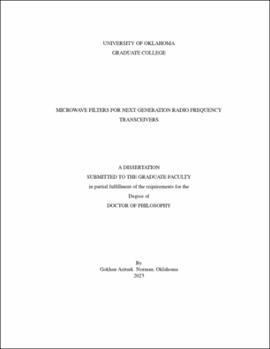| dc.contributor.advisor | Sigmarsson, Hjalti H. | |
| dc.contributor.author | Ariturk, Gokhan | |
| dc.date.accessioned | 2023-08-04T15:37:03Z | |
| dc.date.available | 2023-08-04T15:37:03Z | |
| dc.date.issued | 2023-08-04 | |
| dc.identifier.uri | https://hdl.handle.net/11244/338835 | |
| dc.description.abstract | Increased data rates in wireless communications enforce unprecedented performance metrics on the front-end filters to operate in crowded spectral bands. These requirements include strong selectivity, low insertion loss, and good out-of-band (OOB) rejection in addition to the applicability in complementary metal oxide semiconductor (CMOS) integrated circuit layouts. The acoustic wave (AW) resonator based filter design technology has gained a very important role in the on-chip filter design techniques due to chip-scale physical resonator sizes and the ability of achieving high quality factor values at microwave frequencies. However, conventional synthesis methods used in the design of AW resonator based microwave filters suffer from limited achievable fractional bandwidth (FBW) and weak OOB rejection. The origin of these issues is the limitations on increasing the electromechanical coupling coefficient (kt2) of the resonators, which is an intrinsic property of the piezoelectric material in its design. This dissertation proposes a new class of hybrid acoustic-electromagnetic (Hybrid-ACEM) filters to overcome both of the aforementioned limitations of AW resonator-based filters. In other words, the main goal of this new topology is to maximize the ratio between the achievable FBW and the required kt2. This is achieved by employing one or two electromagnetic (EM) resonators that are placed at purposefully selected stages within the design. In addition, cross-coupling mechanisms are systematically used to reduce the required electromechanical coupling coefficient in certain filter orders. Altogether, the proposed method can achieve much larger FBW values and stronger OOB rejection compared to the conventionally synthesized ladder acoustic wave filters. The effect of finite quality factor of the EM resonators is analyzed. A new algorithm to convert extracted-pole sections to Butterworth-Van-Dyke (BVD) model for large FBW values is also presented. It has been shown in the simulations that FBW-to-kt2 ratios of four or above is achievable with this method. As a proof-of-concept, a sixth-order hybrid canonical prototype with a center frequency of 2.67 GHz and 11.2% FBW is designed and fabricated. The acoustic wave resonators used in the fabrication have kt2 values of 3.5%. The fabricated prototype proves the validity of the proposed method for achieving FBW values of 30% with required kt2 values of 7.5%, which is available with the common aluminum nitride (AlN) based bulk acoustic wave resonator technologies of today. The developed technique opens a new pathway to reduce the limitations of integrating microwave filters for future fully on-chip microwave transceivers. | en_US |
| dc.language | en_US | en_US |
| dc.subject | Engineering, Electronics and Electrical. | en_US |
| dc.subject | Acoustic Wave Filters | en_US |
| dc.subject | Microwave Filters | en_US |
| dc.subject | Electromagnetics | en_US |
| dc.subject | RF Circuits | en_US |
| dc.title | Microwave filters for next generation radio frequency transceivers | en_US |
| dc.contributor.committeeMember | Saeedi, Shahrokh | |
| dc.contributor.committeeMember | Salazar-Cerreno, Jorge L. | |
| dc.contributor.committeeMember | Marino Valle, Alberto | |
| dc.contributor.committeeMember | Goodman, Nathan A. | |
| dc.date.manuscript | 2023-07-28 | |
| dc.thesis.degree | Ph.D. | en_US |
| ou.group | Gallogly College of Engineering::School of Electrical and Computer Engineering | en_US |
| shareok.orcid | 0000-0001-7920-1275 | en_US |
